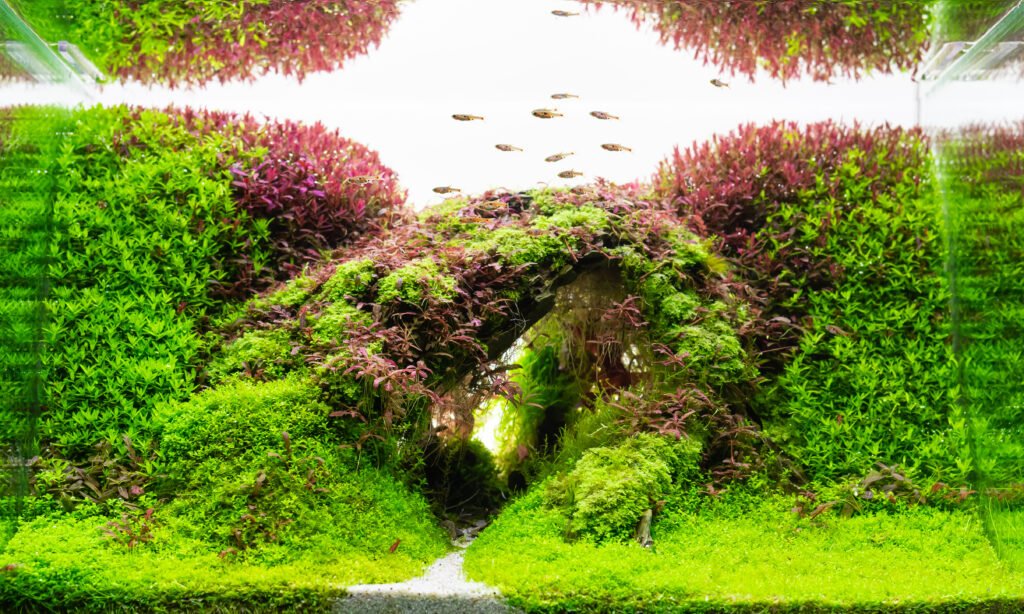Incorporating live plants into your shrimp tank offers numerous benefits that go beyond just enhancing the tank’s aesthetics. Live plants play a crucial role in creating a healthy, balanced environment that supports the well-being of your shrimp. This guide will explore the various advantages of adding live plants to your shrimp tank and provide tips on selecting and maintaining them.
.

Improved Water Quality
Live plants are natural filters that help improve water quality by absorbing harmful compounds and stabilizing water parameters.
•Nutrient Absorption: Plants absorb nitrates, phosphates, and other nutrients from the water, reducing the risk of algae blooms and maintaining a healthier environment for your shrimp.
•Oxygenation: During photosynthesis, plants release oxygen into the water, which is essential for maintaining a well-oxygenated tank, especially in densely populated tanks.
•pH Stabilization: Certain plants can help stabilize the pH levels in your tank, creating a more stable environment for your shrimp.
Natural Grazing and Food Source
Live plants provide a natural grazing area for shrimp, contributing to their diet and overall health.
•Biofilm and Algae Growth: The surfaces of live plants encourage the growth of biofilm and algae, which are natural food sources for shrimp. This constant availability of food helps reduce the need for frequent supplemental feeding.
•Leaf Litter: Some plants, like Indian Almond Leaves, can be used as both a decorative element and a food source. As the leaves break down, they release tannins and other compounds that shrimp can consume.
Enhanced Tank Aesthetics
Live plants add beauty and complexity to your shrimp tank, making it more visually appealing.
•Natural Look: A tank filled with live plants mimics the natural habitat of shrimp, creating a more authentic and serene environment.
•Color Contrast: The green of the plants contrasts beautifully with the vibrant colors of your shrimp, making them stand out more prominently in the tank.
•Variety: With a wide range of plant species available, you can create unique aquascapes that reflect your personal style.
Shelter and Hiding Spots
Shrimp, especially juveniles, benefit from having ample hiding spots within the tank.
•Protection: Live plants provide shelter where shrimp can hide from potential threats, such as more aggressive tank mates or during vulnerable times like molting.
•Breeding: For breeding shrimp, live plants offer safe places for females to carry eggs and for baby shrimp to hide and grow without being disturbed.
Reduction of Stress
A well-planted tank helps reduce stress among shrimp by creating a more natural and comfortable environment.
•Cover and Security: Shrimp feel more secure when they have places to hide and explore, which reduces their stress levels and encourages more natural behaviors.
•Environmental Enrichment: The presence of live plants adds complexity to the tank environment, keeping shrimp active and engaged.
Low Maintenance and Cost-Effective
Contrary to popular belief, many live plants are low-maintenance and can be a cost-effective addition to your shrimp tank.
•Hardy Species: Plants like Java Moss, Anubias, and Cryptocoryne are hardy and require minimal care, making them ideal for beginners.
•Long-Term Investment: Once established, live plants continue to grow and thrive, providing long-term benefits with minimal ongoing costs.
Tips for Selecting and Maintaining Live Plants
When choosing plants for your shrimp tank, consider the following tips:
•Light Requirements: Ensure that the plants you select match the lighting conditions of your tank. Low-light plants like Java Fern and Anubias are ideal for tanks with moderate lighting.
•Substrate: Some plants require nutrient-rich substrates to thrive, while others like mosses and floating plants can grow without being anchored to the substrate.
•Water Parameters: Choose plants that are compatible with the water parameters preferred by your shrimp. Most popular shrimp species thrive in slightly acidic to neutral pH, and the plants should be able to tolerate these conditions.
•Regular Maintenance: Trim and prune plants regularly to prevent overgrowth and ensure that they do not block light from reaching other plants or areas of the tank.
Conclusion
Incorporating live plants into your shrimp tank offers numerous benefits that enhance both the aesthetics and functionality of the tank. From improving water quality to providing natural food sources and shelter, live plants create a healthier, more balanced environment for your shrimp to thrive. Whether you’re a beginner or an experienced aquarist, adding live plants to your tank is a step towards a more vibrant and successful shrimp-keeping experience.